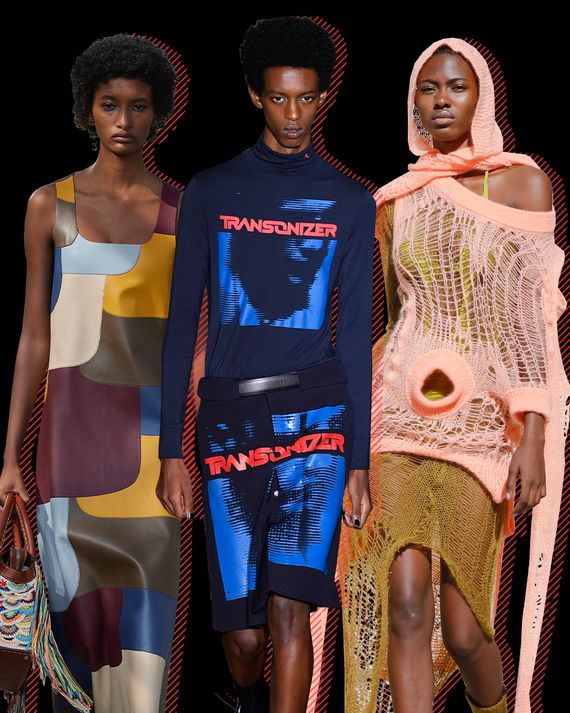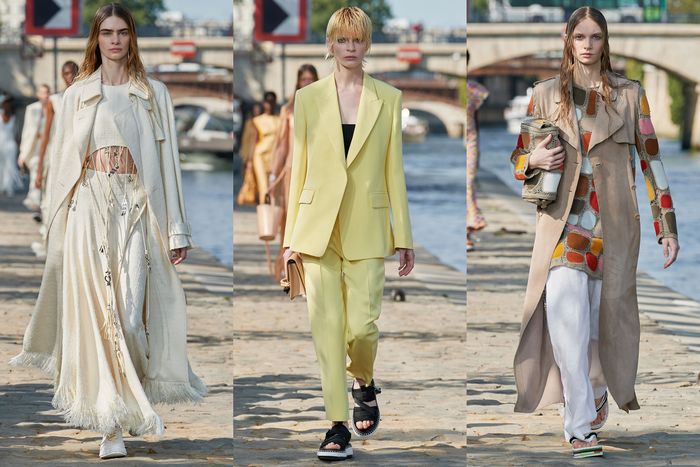
At his spring men’s and women’s show on Friday, Raf Simons had the designers Demna Gvasalia (Balenciaga), Pieter Mulier (Alaïa), and Jack McCollough and Lazaro Hernandez (Proenza Schouler) in the front row. And barely recognizable behind his mask was Patrizio Bertelli, the chief executive of Prada, where Simons is co–creative director with Miuccia Prada.
But this was Simons’s gig, for his Antwerp-based label, and it was quite remarkable. First of all, almost 80 percent of the collection was unisex, though I didn’t notice during the show which gender was in the many skirts and dresses or, for that matter, the blazers and oversized dress shirts. Male models have been the norm in the women’s collections for a few years, dressed in typically feminine garments. But that’s not why I didn’t notice the genders of the models. I was looking at the silhouette of Simons’s suits.
Who expects an interesting new line from a suit today, or even from clothing generally? And who even looks at a jacket and skirt as something cool and desirable? There have been plenty of pantsuits on the runways this season, but very few designers have bothered with skirts and jackets. Maria Grazia Chiuri did them for Dior, but her perky, 1960s-inspired versions hardly looked new.
Simons’s jackets were cut loose on the body, without being sloppy or oversized, and the knee-length skirts appeared to be pleated, though not exactly box-pleated. They were shown with thin black socks and thick-soled black brogues. In fact, I learned later from Simons, the shoes were custom-made, and it showed. All in all, the suit looked relaxed, on any model, and I found myself wondering what Simons had done to make such a loveless garment seem so desirable that I wanted one myself. (I can’t say I’ve felt that about anything else this season.)
“The hard reality is that people want hoodies and sweatshirts,” Simons told me. So the question that motivated him and his team in Antwerp was how to turn those very simple shapes into a more sophisticated form — namely, a suit, a dress, a dress shirt. Photographs of the collection, which is mostly in dark hues (apart from the shirts) probably won’t do justice to the fit and silhouette, how very nearly they affect the ease and attitude of a sweatshirt and shorts. What they have which is different, of course, is the element of fashion — something new and hard to pinpoint.
Simons did a similar thing with dresses. The form is not a sack, exactly, and it’s not a tunic. But it certainly functions like a sweatshirt, and in black or navy-blue industrial nylon, it looks distinctive. Indeed, the fabric reads slightly as couture, though it’s clearly not. Simons told me the shape of the dress actually comes from a 19th-century linen garment that women wore to do activities at home, like painting. Call it a house dress. It’s also similar to the type of smocks that both female and male artists have worn over the centuries. “Creative people never had that strict definition about what a man or woman could wear,” he noted. They were already blurring gender lines, at least in their painting attire.
Simons gave the dress shirts the same consideration. In order to prevent them from looking like office gear, he blew up the stripes and widened the cuffs. They were shown alone, with a skirt, or layered under a loose knit top.
All these forms have survived time, largely because they are simple. Simons gave himself the challenge of relating them to the things young (and not so young) people want to wear. The upshot, in the case of the suit, was a compelling new silhouette. That challenge is something the rest of the industry also must consider.
Rick Owens frequently travels between the home he shares in Paris with his partner, Michèle Lamy, and an apartment on the Venice Lido, which is a short drive to his garment factories. It was on the Lido that he staged what he calls his “COVID collections.” Owens isn’t wistful about those shows, which only members of his staff were permitted to see in person. But he also didn’t want to forget them.
Around noon on Thursday, against the loveliest Parisian sky, two models in flowing garments stood on the roof of the Palais de Tokyo and flung papery bits down to the runway and the audience. The bits were actually jasmine leaves that Owens collected on his Lido terrace. On many minds here has been the question: How should designers mark the return of live shows? With the same old hoopla? To a great extent, that is what they’ve done. But in all things, Owens remains steadfastly personal. As brutalist as his vision sometimes is, with shapes that suggest mangled armor or futurist shells, it conceals a soft heart. Leading the procession of models, in a dark harness top and a short, sculptural skirt with platform Spartan boots, was Lamy. That was a first, as far as I can recall.
“Should returning to the Paris runways be about humility and a lesson learned,” Owens asked in his show notes, “or carpe diem?”
The audience of mostly European and American writers and stylists (there are almost no guests from other parts of the world here) clearly wanted Owens to seize the day.
So he did: with long black dresses cut close to the body and carved out around the breasts, sexy bodysuits with hollowed-out fronts and sides, and wonderful cocoon-shaped, zip-closed bomber jackets in leather and pleated nylon. The mood hovered between sex (those bodysuits and deep-cleavage dresses) and regal or holy glamour. I suppose you don’t grow up in California, as Owens did, and then spend much of your life in France and Italy without being influenced by both Hollywood and, here, religious shrines and symbols. Some of Owens’s grand-looking robes and broad, peaked shoulders reflected both, Joan Crawford meets a saint.
Did the collection seem a bit overloaded with details? In a way, yes. Maybe that’s why I was struck by a tunic in orange denim with a funnel neck and long sleeves, its hem partially tucked into pink shorts. Shown with white Spartan platforms, the outfit seemed at odds with the collection, though not with the reality of everyday life. I wish Owens had done more looks like that one.
Next up was Chloé, held along an embankment of the Seine with river traffic in the background. Many designers are conscious of giving their clothes a realistic context, whether by showing them in a public space — Pierpaolo Piccioli, for example, plans to use a street for Valentino on Friday night — or with a diverse cast of models. Chloé’s Gabriela Hearst also scaled back the number of looks in her show, to just 31.
That decision squares with her aim to make Chloé more environmentally responsible, and it hardly limited her expression. She made a strong case for long boho dresses in creamy wool with streamers, a practical and flattering pantsuit in beige or custard yellow, and slim coats, including one with insets of crochet and leather patchwork in the back. It all felt like a concise, packable wardrobe. According to her show notes, macramé pieces (and bags) were made from shredded and respun garments from past collections, while thick-soled sandals were a project with Ocean Sole, a group that upcycles old flip-flops.
More From Paris Fashion Week
- The Best Street Style at Paris Fashion Week
- Remembering Alber Elbaz
- Edginess and Decadence for a Surprising Paris Finale






